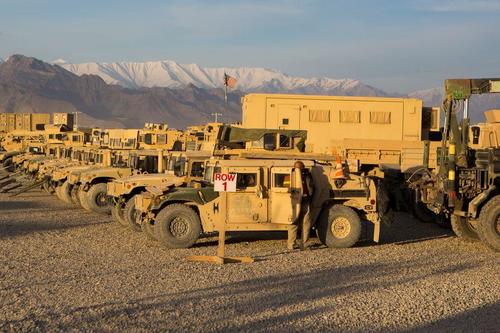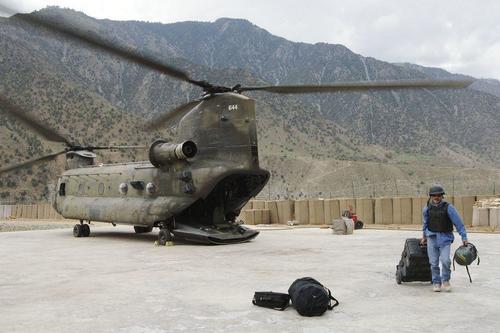The Real Winners In Afghanistan: Private Contractors
After 20 years in Afghanistan which featured more than 22,000 US servicemember casualties, an official 46,000 civilians killed – including 7 children droned by the Biden administration on its way out, and trillions added to the US national debt, there are really two winners;
The Taliban – which carved a path to Kabul in a matter of days and recovered billions of US military hardware left behind during the botch Biden withdrawal, and private contractors, who have raked in trillions according to the Wall Street Journal.
Those who benefited from the outpouring of government money range from major weapons manufacturers to entrepreneurs. A California businessman running a bar in Kyrgyzstan started a fuel business that brought in billions in revenue. A young Afghan translator transformed a deal to provide forces with bed sheets into a business empire including a TV station and a domestic airline.
Two Army National Guardsmen from Ohio started a small business providing the military with Afghan interpreters that grew to become one of the Army’s top contractors. It collected nearly $4 billion in federal contracts, according to publicly available records. -WSJ
Of the $14 trillion spent by the Pentagon since the Sept. 11, 2001 attacks, approximately one-third to one-half of that went to contractors, with $2.1 trillion of that going to Lockheed Martin, Boeing, General Dynamics, Raytheon and Northrop Grumman – for services, weapons and supplies, according to the Costs of War Project maintained by Brown University.
Of course, a constellation of smaller contractors made billions for various enterprises – including training Afghan (now Taliban) police officers, infrastructure expansion such as roads, establishing schools, and providing security services to Western diplomats, according to the report.
According to former Green Beret and acting Trump Defense secretary Christopher Miller, “you have to outsource so much to contractors to do your operations” when you’re running an all-volunteer military without a draft.
Approximately $150 billion of the funds spent in Afghanistan – a drop in the bucket – was overseen by the US Special Inspector General for Afghan Reconstruction, which catalogued waste and fraud across hundreds of reports. For example, a survey released in 2021 found that of $7.8 billion subject to inspection, just $1.2 billion, or 15%, was spent as expected on hospitals, factories, roads and bridges. At least $2.4 billion was spent on military planes, police offices, farming initiatives and other development projects that were destroyed, abandoned, or repurposed.
In yet more examples, $6 million was wasted on a project to import nine Italian goats in the hopes of boosting Afghanistan’s cashmere market. $270 million was allocated by the US Agency for International Development to build 1,200 miles of gravel road – a project which was canceled after just 100 miles were built in three years and over 125 dead due to insurgent attacks.
The Pentagon has defended its slush fund imperialism – with spokesman Maj. Rob Lodewick claiming that the “dedicated support offered by many thousands of contractors to U.S. military missions in Afghanistan served many important roles to include freeing up uniformed forces for vital war fighting efforts.”
The Inspector General who analyzed the reconstruction since 2012, John Sopko, said that many of the contractors were making best efforts to fulfill requirements by policymakers who made terrible decisions.
“It’s so easy with a broad brush to say that all contractors are crooks or war profiteers,” said Sopko. “The fact that some of them made a lot of money—that’s the capitalist system.“
The use of contractors is not new in American history. During the revolutionary war, the Continental Army made use of private firms for their military supply chain, and even to carry out raids on ships. During WWII, the US used one contractor for every seven service members, according to the Congressional Budget Office.
The practice really took off in the 1990s surrounding the Gulf War, however, which accelerated even more after 9/11 when the United States set out to prosecute a global war on terror which left the Pentagon short-handed after downsizing the US military after the Cold War.
In 2008, the U.S. had 187,900 troops in Afghanistan and Iraq, the peak of the U.S. deployment, and 203,660 contractor personnel.
The ratio of contractors to troops went up. When President Barack Obama ordered most U.S. troops to leave Afghanistan at the end of his second term, more than 26,000 contractors were in Afghanistan, compared with 9,800 troops.
By the time President Donald Trump left office four years later, 18,000 contractors remained in Afghanistan, along with 2,500 troops. -WSJ
“Contracting seems to be moving in only one direction—increasing—regardless of whether there is a Democrat or Republican in the White House,” said Heidi Peltier, program manager at the Costs of War Project, who added that the reliance on contractors has led to the rise of the “camo economy,” in which the true costs of war are camouflaged.
According to statics from the Labor Department, more than 7,000 US service members died during two decades of war, while 3,500 US contractors died in Afghanistan and Iraq.
Read the rest of the report here.
Tyler Durden
Mon, 01/03/2022 – 21:20
via ZeroHedge News https://ift.tt/3qOvPy2 Tyler Durden

